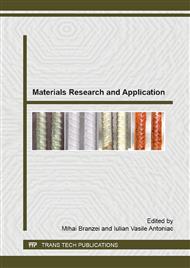[1]
P. Nau, C.J. Clark, M. Fisher, G. Walker, B.J. Needleman, E.C. Ellison, P. Muscarella, Modified rives-stoppa repair for abdominal incisional hernias, Health. 2: 2, (2010) 162-169.
DOI: 10.4236/health.2010.22024
Google Scholar
[2]
J.W.A. Burger, R.W. Luijendijk, W.C.J. Hop, J.A. Halm, E.G.G. Verdaasdonk, J. Jeekel, Long-Term Follow-up of a Randomized Controlled Trial of Suture Versus Mesh Repair of Incisional Hernia, Annals of Surgery. 240: 4, (2004) 578–585.
DOI: 10.1097/01.sla.0000141193.08524.e7
Google Scholar
[3]
E. Iversen, A. Lykke, M. Hensler, L.N. Jorgensen, Abdominal wall hernia repair with a composite ePTFE/polypropylene mesh: clinical outcome and quality of life in 152 patients, Hernia. 14: 6, (2010) 555-60.
DOI: 10.1007/s10029-010-0729-1
Google Scholar
[4]
J.M. Bellón, M. Rodríguez, N. García-Honduvilla, V. Gómez-Gil, G. Pascual, J. Buján, Postimplant behavior of lightweight polypropylene meshes in an experimental model of abdominal hernia, Journal of Investigative Surgery. 21: 5, (2008) 280-287.
DOI: 10.1080/08941930802029937
Google Scholar
[5]
U. Klinge, B. Klosterhalfen, M. Müller, V. Schumpelick, Foreign body reaction to meshes used for the repair of abdominal wall hernias, Eur J Surg. 165(7), (1999) 665-73.
DOI: 10.1080/11024159950189726
Google Scholar
[6]
K. Junge, M. Binnebösel, K.T. von Trotha, R. Rosch, U. Klinge, U.P. Neumann, P. Jansen, Mesh biocompatibility: effects of cellular inflammation and tissue remodelling, Langenbecks Arch Surg. 397(2), (2012) 255-70.
DOI: 10.1007/s00423-011-0780-0
Google Scholar
[7]
A. Coda, R. Lamberti, S. Martorana, Classification of prosthetics used in hernia repair based on weight and biomaterial, Hernia. 16(1), (2012) 9-20.
DOI: 10.1007/s10029-011-0868-z
Google Scholar
[8]
U. Klinge, K. Junge, B. Spellerberg, C. Piroth, B. Klosterhalfen, V. Schumpelick, Do multifilament alloplastic meshes increase the infection rate? Analysis of the polymeric surface, the bacteria adherence, and the in vivo consequences in a rat model, J Biomed Mater Res. 63(6), (2002).
DOI: 10.1002/jbm.10449
Google Scholar
[9]
M.J. Tolino, D.E. Tripoloni, R. Ratto, M.I. Garcia, Infections associated with prosthetic repairs of abdominal wall hernias: pathology, management and results, Hernia. 13(6), (2009) 631-7.
DOI: 10.1007/s10029-009-0541-y
Google Scholar
[10]
G. Peach, L.C. Tan, Small bowel obstruction and perforation due to a displaced spiral tacker: a rare complication of laparoscopic inguinal hernia repair, Hernia. 12(3), (2008) : 303-5.
DOI: 10.1007/s10029-007-0289-1
Google Scholar
[11]
H.L. Fitzgerald, S.B. Orenstein, Y.W. Novitsky, Small bowel obstruction owing to displaced spiral tack after laparoscopic TAPP inguinal hernia repair, Surg Laparosc Endosc Percutan Tech. 20(3), (2010) 132-5.
DOI: 10.1097/sle.0b013e3181dfbc05
Google Scholar
[12]
K.A. LeBlanc, Tack Hernia: A New Entity., JSLS : Journal of the Society of Laparoendoscopic Surgeons. 7(4), (2003) 383–387.
Google Scholar
[13]
M.H. Schreinemacher, K.W. van Barneveld, E. Peeters, M. Miserez, M.J. Gijbels, J.W. Greve, N.D. Bouvy, Adhesions to sutures, tackers, and glue for intraperitoneal mesh fixation: an experimental study, Hernia. 18(6), (2014) 865-72.
DOI: 10.1007/s10029-013-1192-6
Google Scholar
[14]
N. Stoikes, D. Webb, B. Powell, G. Voeller, Preliminary report of a sutureless onlay technique for incisional hernia repair using fibrin glue alone for mesh fixation, Am Surg. 79(11), (2013) 1177-80.
DOI: 10.1177/000313481307901121
Google Scholar
[15]
J.F. Kukleta, C. Freytag, M. Weber, Efficiency and safety of mesh fixation in laparoscopic inguinal hernia repair using n-butyl cyanoacrylate: long-term biocompatibility in over 1, 300 mesh fixations, Hernia. 16(2), (2012) 153-62.
DOI: 10.1007/s10029-011-0887-9
Google Scholar
[16]
E.C. Nelson, T.J. Vidovszky, Composite mesh migration into the sigmoid colon following ventral hernia repair, Hernia. 15(1), (2011) 101-3.
DOI: 10.1007/s10029-009-0623-x
Google Scholar


